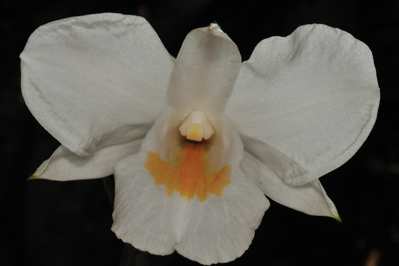The Plant
Epiphyte. With 10 to 18 cm long, decurved, pendulous stems, covered with reddish brown hairs throughout. Leaves many, alternatively arranged, leathery, lanceolate, acuminate, 4 to 5 cm long and 1.5 cm in width, margins and dorsal part covered with hairs as that of the stem.
The Flower
Flowers leaf opposed, in short stout racemes, 4 to 6 each, with large triangular hairy green bracts. Sepals sub-equal, ovate to lanceolate, hairy on the outer surface, spreading. Petals narrower than the petals, spreading, not hairy. Lip as long as the petals and sepals, lanceolate with its apex curved up to form a boat like structure, margins not lobed, disc with an elongate callus near its apex.
Sepals, petals and lip pure white. Half the length of the lip margins from the base is flushed with crimson red, its disc has a bright elongated yellow marking near to its apex. The anther cap is spotted with a bright and attractive crimson red shade. Sepals are externally covered with reddish brown hairs.

The Pursuit
A plant of the region which was illegally collected from the wild for trade, thus destroying its entire population. I had a feeling that some of the plant collectors of the region may be knowing its earlier habitats. Even though these plant collectors are very secretive in disclosing the locations, some will do so for some financial returns. Thus I got a vague idea of a location where this species was in plenty some 20 years back.
As this species got long pendulous stems, I was sure I will be able to locate it, if it was somewhere in the wild. I visited the said location in the early monsoon for survey. The location was around 2200 ft high and surrounded with tall trees and heavy undergrowths. The whole day I searched the area and I trekked up to almost 4000 ft. It is a practice I follow to take another route while returning, so that I can survey more places. If the route is uphill, while going up I take the long route and while returning I prefer to take short cuts. As I was negotiating a short cut route downhill, to my surprise I found a huge plant with almost 18 stems, some even more than 15 cm long on a small tree. It was a surprise that such a huge plant survived there without the notice of any collectors. On close observation I understood that flower buds just started emerging and it will take another 20 to 30 days for it to bloom. That made me so worried, as I feared that it may be picked up from there by somebody before I document it.
I had a good friend in that area, a very influential person of the locality. I phoned him and met him at his home that evening and shared with him about the situation. We visited the location the next day. He was also aware of the presence of collectors and their illegal activities in that area. He suggested that we should cover the whole plant with some branches so that it should not be noticed easily. I was afraid that it will damage the plant, but was left with no other options. He and his friends brought a few broken tree branches and placed it in a slanting position on the tree trunk in such a way it covered the plant. They did it very carefully without damaging any of the slender pendulous stems of the plant. My friend’s contacts there volunteered themselves to take care of the plant till it blooms. I too visited the location thrice in those twenty five days to analyze the plant and its growth. My friend informed me over phone about the first bloom and I made this wonderful photograph of the species. After that I visited 4 more times to document other flowers from the same plant.
Later on, after all the flowers withered, we translocated the plant to another location which was deep inside the forest to protect it. This year too I visited its new location to see them in flowers.
Reference:
King, G. & Pantling, R. (1898). The Orchids of the Sikkim-Himalayas. Ann. Roy. Bot. Garden.(Calcutta). Eria rufinula Reichb., Page no 128 – 129.



